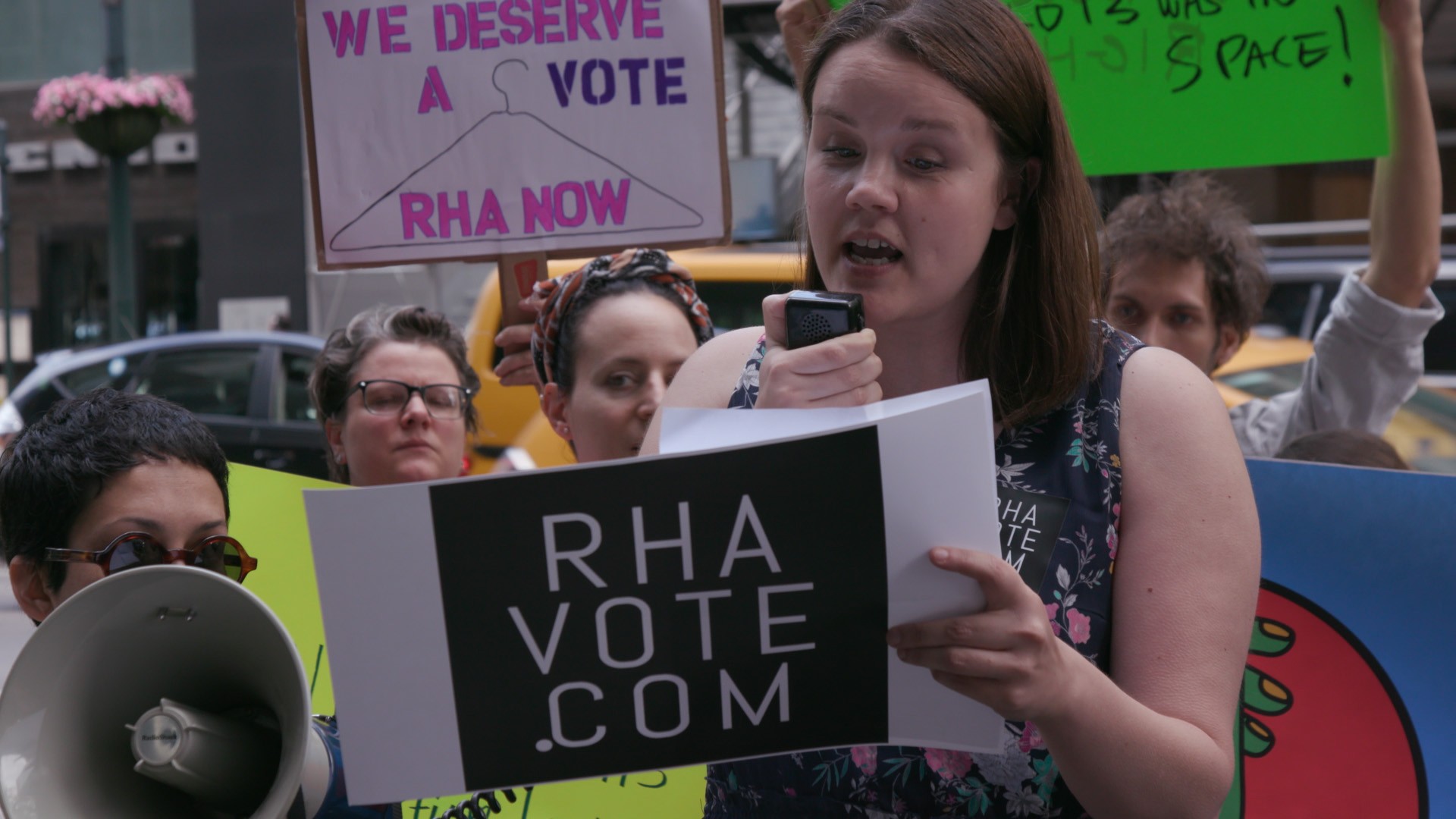Keith Brofsky/Getty Images
Update 11/7/18: Democrats took control of the New York state senate by winning eight seats formerly held by Republicans; Democrats unseated five Republican incumbents and won three open seats. As the New York Times notes, now that Democrats control the senate in addition to the state assembly and Governor's office, it positions the party "to unleash a cascade of long-stymied progressive legislation." That includes the Reproductive Health Act (RHA) which advocates expect will be introduced in the state senate in January 2019.Katharine Bodde, senior policy council at the New York Civil Liberties Union, said in a statement: "In a climate where states across the country are poised to ban abortion, New York must take this opportunity to be a leader for women’s equality and health by passing the Reproductive Health Act—the women of New York, and indeed the rest of the country, are relying on it."The day Brett Kavanaugh was confirmed to the Supreme Court, New York governor Andrew Cuomo put out a press release addressing concerns that the Kavanaugh court could limit abortion access. It said, in part, “We will not wait for our rights to be taken away. Here in New York, I vow to codify Roe v. Wade within the first 30 days of my next administration.”But Cuomo can only do that if the New York state senate holds a vote on a bill that it has basically ignored for a decade while under Republican control. Republicans currently have a one-seat majority in the state senate and advocates in New York are hopeful that energy surrounding the midterms at the national level could help at the state level, too. If Democrats flip one seat and take control of the state senate, the bill protecting abortion access could get passed come January.New York was one of the first states to decriminalize abortion, but its abortion laws were actually just an exception in the criminal code: In 1970, the state removed a ban on abortions before 24 weeks of pregnancy and on abortions after 24 weeks if the woman’s life was in danger. This was considered progressive at the time, but within three years, Roe v. Wade established a more progressive edict: It said that states couldn't prohibit abortion at any point during pregnancy if a fetus wasn't viable, or when a woman’s health or life is at risk, says Katharine Bodde, senior policy council at the New York Civil Liberties Union. “New York law doesn’t match those basic constitutional protections,” Bodde says.A bill known as the Reproductive Health Act (RHA) would codify Roe in state law, specifically by putting abortion protections in the public health section of the law. The RHA would also permit abortion later in pregnancy if the fetus isn’t viable or where the pregnancy threatens the mother’s health. Currently, doctors who perform abortions after 24 weeks for reasons other than to save the mother’s life can be prosecuted as criminals in New York.Even though the Supreme Court has reaffirmed the right to abortion if a pregnancy isn’t viable or threatens a woman’s life or health, Bodde says doctors in New York don’t look past the letter of the state law and they don’t provide this care. So people who need to end a pregnancy after that point are put in the position of either having to pay significant amounts of money to travel out of state or carry a risky or nonviable pregnancy to term.The RHA would fix these problems, and the New York state assembly has passed it multiple times since it was first introduced in 2007. The state senate, however, has never brought it to the floor for a vote.Just like in the US House of Representatives, members of the New York state senate are up for reelection every two years. It’s possible that this year’s election could lead to Democrats taking control of New York’s senate—all it would take is flipping one seat, says Erika Christensen, an advocate for the RHA.
Watch More from Tonic:
Christensen knows firsthand how New York law affects women: In 2016, she learned at 30 weeks into her pregnancy that her fetus wouldn’t be able to breathe outside the womb and was shocked to find out that she couldn’t get an abortion in New York. She spent tens of thousands of dollars to travel to Colorado to end the pregnancy.“It all comes down to November 6,” Christensen says, adding that replacing one anti-choice member with one pro-choice member is “what gets us a pro-choice [state] senate majority leader, which is what we need to bring our bill to the floor.”Christensen says there are a lot of opportunities to flip seats, but notes that there are especially close races in District 7 on Long Island and District 22 in South Brooklyn. (She stops short of endorsing candidates because she runs a 501(c)(3) non-profit group.) Republican Marty Golden of District 22 voted against the RHA in May and Republican Elaine Phillips, the state senator for District 7, says she’s pro-choice but told WNYC that she opposes the RHA because it “goes too far” and that’s why she’s voted against it.But what the RHA does is simply align New York law with the baseline constitutional protections from Roe, Bodde says. It’s true that the bill would also allow advanced practice clinicians (APCs) like nurse practitioners and physician assistants to provide abortion care within their scope of practice as determined by their training and education and by medical associations and licensing boards, but eight states already allow APCs to provide medication abortion and another eight permit them to provide procedural abortions, according to the Guttmacher Institute.“New York would certainly not be the first state to allow advanced practice clinicians to provide care, so it is disingenuous when the opposition says this would allow non-doctors to perform abortions,” she says. “How medical professionals are regulated is similar to how other professionals are regulated. If you operate outside of your scope of practice, you are not on legal grounds. It wouldn’t just allow a dentist to provide [abortion] care.”While the RHA was first introduced in 2007, it’s been rendered even more relevant by Kavanaugh’s confirmation of to the Supreme Court, resulting in a conservative majority on the high court that is expected to chip away at abortion access and possibly overturn Roe outright.Christensen points out that addressing the problems with New York state law stands to help women in other states in an indirect way: New York women who need to travel out of state for the procedure are contacting abortion funds to help pay for their travel and care, thus reducing resources for people in more hostile states who might need them. This is despite the fact that the Empire state has a pro-choice electorate: A July 2018 Quinnipiac poll found that 73 percent of New York voters agree with the Roe decision.“Now with Kavanaugh on the court, I think we can be pretty sure that access is just going to get harder and harder. We have patients in other states who we know are going to desperately need the resources of [abortion] funds to travel for this healthcare, we know that. New York should not be draining those resources when we have the pro-choice voting numbers to actually solve the problem at the state level,” Christensen says. “It frees up resources for our sisters in other states.” If women with insurance can get care in-state, their insurance would pay for more of it.In her lobbying of state senators to support the bill, Christensen has collected the stories of women who’ve had to travel out of state for later abortion care. “When we go back to the next [legislative] session [in January] to start pounding the pavement again, I will have added four stories—just since my letter from the end of last session [at the end of June],” she says.Christensen shared the stories of those women and others at a pop-up in Manhattan last month dubbed “The No Choice Travel Agency.” The shop featured the stories of 10 women, mostly New Yorkers, who had to travel out of state to get their care because they learned of medical complications after 24 weeks of pregnancy, or because saving up money for the procedure put them over the time limit. The travel agency featured information on the three states that accept out-of-state patients later in pregnancy: Colorado, New Mexico, and Maryland, as well as info about a newer clinic in Washington, DC.Christensen says the goal of the pop-up was to “bring attention to the fact that we have people getting on planes and flying across the country for healthcare in 2018, from New York. it’s happening more than people would ever guess…We are trying to educate our fellow citizens about the situation, the vast amounts of money people are paying. It doesn’t take long to put together that ‘Oh, only some people are able to afford this.’”Inside the shop, she spoke with many women who had no idea about the law and who then told her their abortion stories. She also found an audience in young men.“I would stand outside with my fliers and say ‘you look like dudes who like to travel.’ They’d start reading and be like ‘what’s going on?’ We would tell them and they’d say ‘I didn’t even know there was a cutoff in New York.’ I’d say ‘yes, this is the deal.’ One guy said: ‘Whoa, that’s really messed up. We should fix that.’”Sign up for our newsletter to get the best of Tonic delivered to your inbox.Correction 11/6/18: This story has been corrected to reflect that Democrats only need to flip one seat, not two, in order to gain control of the New York state senate. We regret the error.
Advertisement
Advertisement
Advertisement
Watch More from Tonic:

Christensen knows firsthand how New York law affects women: In 2016, she learned at 30 weeks into her pregnancy that her fetus wouldn’t be able to breathe outside the womb and was shocked to find out that she couldn’t get an abortion in New York. She spent tens of thousands of dollars to travel to Colorado to end the pregnancy.“It all comes down to November 6,” Christensen says, adding that replacing one anti-choice member with one pro-choice member is “what gets us a pro-choice [state] senate majority leader, which is what we need to bring our bill to the floor.”Christensen says there are a lot of opportunities to flip seats, but notes that there are especially close races in District 7 on Long Island and District 22 in South Brooklyn. (She stops short of endorsing candidates because she runs a 501(c)(3) non-profit group.) Republican Marty Golden of District 22 voted against the RHA in May and Republican Elaine Phillips, the state senator for District 7, says she’s pro-choice but told WNYC that she opposes the RHA because it “goes too far” and that’s why she’s voted against it.But what the RHA does is simply align New York law with the baseline constitutional protections from Roe, Bodde says. It’s true that the bill would also allow advanced practice clinicians (APCs) like nurse practitioners and physician assistants to provide abortion care within their scope of practice as determined by their training and education and by medical associations and licensing boards, but eight states already allow APCs to provide medication abortion and another eight permit them to provide procedural abortions, according to the Guttmacher Institute.
Advertisement
Advertisement
